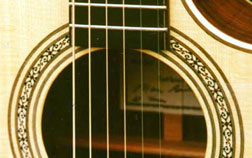As with many other design features on my guitars, the soundhole inlay has gone through a series of transformations over the years. In fact my first few instruments had a simple ring of alternating dark & light wooden strips. This was simple to execute and served the purpose but I felt the need to be challenged as consumer demands became more nuanced.
As stated elsewhere, when I started in the mid 1970's a major influence was the guitars of Jean Larrivee, and a feature that set his instruments apart was his use of a classical style rosette around the soundhole. Since this appealed to me, I set about learning to make and inlay a mosaic design of my own - (see photo below). Most of my guitars built between the late 70's and the early 90's had this type of soundhole design.
Most of my guitars built between the late 70's and the early 90's had this type of soundhole design.
Gradually I decided that a change was in order. At first I switched my steel string models (more on this later) but kept making rosettes for my classicals. It soon became obvious though, that the considerable amount of work involved in making mosaic inlays didn’t make sense considering the number of instruments involved, and I eventually changed to bought rosettes for my classical models. But back to the steel string models. At this time I decided that I preferred the somewhat conservative look of the traditional three line Martin style inlay. There is something timelessly classic about that look, so I changed direction and with minor variations, used this style through the 90's.
Simple Martin style, three line inlay.
Though fairly satisfied, I eventually found that for my headstock shape and bridge design, as well as the soundhole, I really needed something more personal. These changes began a number of years ago with my headstock design, followed by the bridge and finally, in the past year the soundhole.
In redesigning the soundhole, I wanted something attractive and, to some extent unique. In addition, I hoped to incorporate at least some natural colour, having always felt the traditional white/black soundhole somewhat stark looking. I’m glad to say that the new soundhole design achieves these goals successfully.
The concept incorporates a two line pattern and utilizes either the wood of the back and sides or a complimentary wood to great effect. One final benefit of this change is that I can now use one design on my classicals as well as my steel strings, something I’ve wanted for a long time.
Soundhole inlay done in Cocobolo
After thinking about it for quite some time, I have finally started to offer, in addition to my normal inlayed woods, various types of burled and spalted soundhole inlays. The beauty of these inlays is that each one is quite unique, being an abnormal growth on the side of the tree (burled) or the spread of a fungus after the tree has died (spalted). The two soundholes pictured are just a start and I will be constantly looking for striking examples of these beautiful woods.
Intensely Spalted Maple (This Spalted is amazing and I’m lucky to have found it and I still have some!)
Soundhole inlay done in Box Elder Burl
Custom soundhole inlay done in dark Burl







